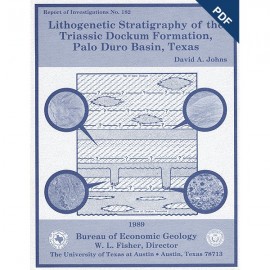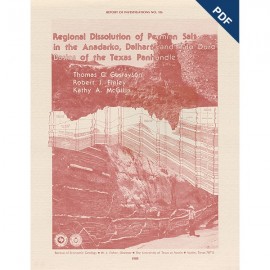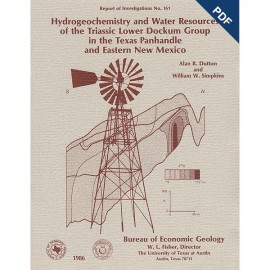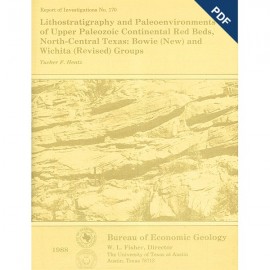Reports of Investigations
-
Books & Reports
- Reports of Investigations
- Guidebooks
- Udden Series
- Geological Circulars
- Down To Earth
- Atlases of Major Oil and Gas Reservoirs
- Texas Memorial Museum Publications
- Environmental Geologic Atlas of the Texas Coastal Zone
- Mineral Resource Circulars
- Other Reports
- Seminars and Workshops
- Handbooks
- Submerged Lands of Texas
- Symposia
- Annual Reports
- Open File Reports
-
Maps & Cross Sections
- Thematic Maps
- Miscellaneous Maps, Charts & Sections
- Geologic Atlas of Texas
- STATEMAP Project Maps
- Geologic Quadrangle Maps
- Cross Sections
- Highway Geology Map
- Energy and Mineral Resource Maps
- Shoreline Change and Other Posters
- Wilcox Group, East Texas, Geological / Hydrological Folios
- Bouguer Gravity Atlas of Texas
- River Basin Regional Studies
- Featured Maps
- Posters
- Teachers & the Public
-
Geological Society Publications
- Gulf Coast Association of Geological Societies
- Alabama Geological Society
- Austin Geological Society
- Corpus Christi Geological Society
- Houston Geological Society
- Lafayette Geological Society
- Mississippi Geological Society
- New Orleans Geological Society
- South Texas Geological Society
- GCS SEPM Publications
- Historic BEG & UT Series
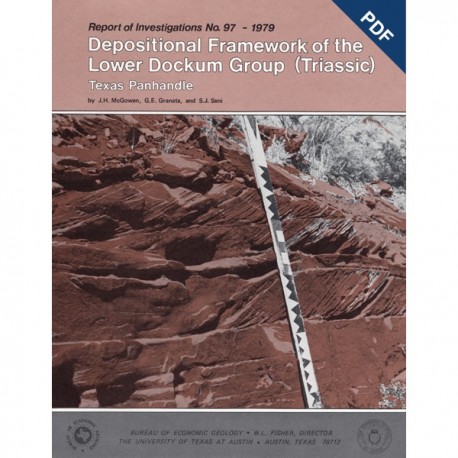
Depositional Framework of the Lower Dockum Group (Triassic), Texas Panhandle. Digital Download
RI0097D
A free, digital version of this publication can be found on: Texas ScholarWorks
To purchase a print version (if available): RI0097
RI0097D. Depositional Framework of the Lower Dockum Group (Triassic), Texas Panhandle, by J. H. McGowen, G. E. Granata, and S. J. Seni. 60 p., 43 figs., 2 tables, 1979. doi.org/10.23867/RI0097D. Downloadable PDF.
To purchase this publication in book format, please order RI0097.
ABSTRACT
The Upper Triassic Dockum Group of Texas and New Mexico is composed of 200 to 2,000 feet of complexly interrelated terrigenous clastic facies ranging from mudstone to conglomerate. The lower 200 to 1,000 feet of the Dockum accumulated in a fluvial-lacustrine basin defined by the Amarillo Uplift - Bravo Dome on the north and the Glass Mountains on the south.
Outcrop and subsurface data indicate that (1) the basin was filled peripherally, (2) the sediment sources were in Oklahoma, Texas, and New Mexico, and (3) the relict Paleozoic structures in concert with alternating humid and arid climatic cycles exerted considerable influence on the depositional style of the Dockum. An unconformity between the Permian and Triassic is obvious in the northern part of the basin, but physical evidence of an unconformity is lacking in the central basin area.
Arid Permian conditions gave way gradually to more humid conditions of the Triassic. Initial deposits of the Dockum, which record these humid conditions, accumulated in (1) braided and meandering streams, (2) alluvial fans and fan deltas, (3) high-constructive lobate deltas, and (4) lakes. Alluvial fans and fan deltas were best developed in northern and southern parts of the basin, whereas high-constructive lobate deltas dominated central basin areas. A change from humid to arid conditions produced (1) lowering of base level, (2) erosion (cannibalization) of older Dockum deposits, (3) replacement of meandering fluvial systems by headwardly eroding valleys and braided streams, and (4) development of small fan deltas.
Several depositional cycles are recognized in the area defined by Dickens, Crosby, Kent, and Garza Counties, Texas. A cycle comprises facies that accumulated during one high stand and one low stand of lake level. Thin progradational delta and attendant meanderbelt systems were deposited during high-stand, relatively stable base-level conditions. Progradational delta sequences are composed of extrabasinal sediments ranging in texture from clay to gravel. A typical delta sequence consists of lacustrine and prodelta mudstone-siltstone, delta-front siltstone-sandstone, channel-mouth bar and distributary sandstone, and meanderbelt sandstone-conglomerate. Splay units, consisting of poorly sorted intrabasinal sandstone and conglomerate, are constituents of interdistributary and floodplain deposits. Most delta sequences were partly cannibalized by superimposed meandering streams that migrated across the area.
With a shift toward arid conditions there was a lowering of base level accompanied by erosion of subjacent Dockum deposits. Sediment that composes the low-stand facies association ranges from reddish-brown mudstone to conglomerate. Abrupt vertical and lateral textural changes characterize these low-stand deposits. Lower Dockum red beds consist of (1) lacustrine mudstone, (2) prodelta mudstone-siltstone, (3) delta-front (delta foresets) siltstone to conglomerate, (4) delta-platform sandstone and conglomerate, and (5) interdeltaic mudstone exhibiting desiccation features, rare gypsum, salt hoppers, and chert.
Keywords: clastics, Crosby County, deposition, Dickens County, Dockum Group, Garza County, Kent County, lithofacies, Mesozoic, New Mexico, Oldham County, petrology, sedimentary rocks, sedimentation, Texas, Texas Panhandle, Triassic, Upper Triassic, uranium
Citation
McGowen, J. H., Granata, G. E., and Seni, S. J., 1979, Depositional Framework of the Lower Dockum Group (Triassic), Texas Panhandle: The University of texas at Austin, Bureau of Economic Geology, report of Investigations No. 97, 60 p.

